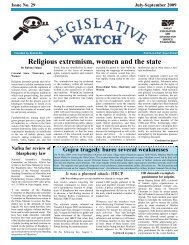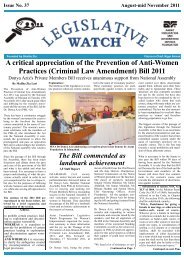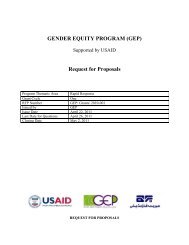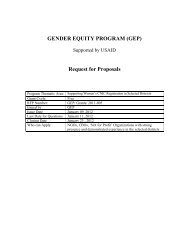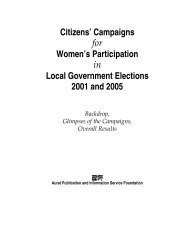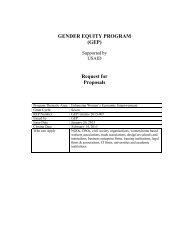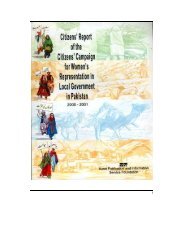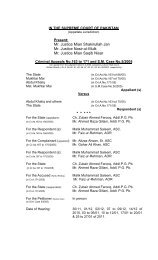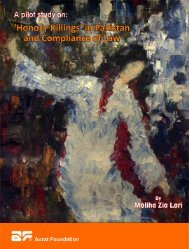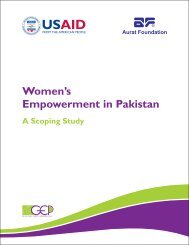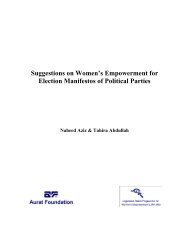Legislative Quotas for Women: A global and ... - Aurat Foundation
Legislative Quotas for Women: A global and ... - Aurat Foundation
Legislative Quotas for Women: A global and ... - Aurat Foundation
- No tags were found...
You also want an ePaper? Increase the reach of your titles
YUMPU automatically turns print PDFs into web optimized ePapers that Google loves.
<strong>Legislative</strong> <strong>Quotas</strong><strong>for</strong> <strong>Women</strong>A Global & South Asian Overviewof Types <strong>and</strong> NumbersPublished under<strong>Legislative</strong> Watch Programme <strong>for</strong><strong>Women</strong>’s Empowerment<strong>Aurat</strong> <strong>Foundation</strong>
All rights reservedThis publication is provided gratis or sold, subject to the condition that it shallnot, by way of trade or otherwise, be lent, re-sold, hired out or otherwisecirculated without the publisher’s prior consent in any <strong>for</strong>m of binding or coverother than in which it is published <strong>and</strong> without a similar condition beingimposed on the subsequent publisher.Preferences to this report <strong>and</strong> excerpts of the report can be reproduced with dueacknowledge of the publication <strong>and</strong> <strong>Aurat</strong> Publication <strong>and</strong> In<strong>for</strong>mation Service<strong>Foundation</strong> (AF).Published by: <strong>Aurat</strong> Publication <strong>and</strong> In<strong>for</strong>mation Service <strong>Foundation</strong>Title design by: Shahzad AshrafPrinting by: Crystal PrintersDate of publication: July, 2012Printing funded by: MFA, Norway
Table of ContentsNo. Content Page12345IntroductionBackground <strong>and</strong> ContextBackgroundIntroduction of special measuresDoes women’s participation make any difference? Do thenumbers matter?The <strong>Quotas</strong>Arguments against <strong>and</strong> in favour of the quota system Arguments against the quota system Arguments in favour of the quota systemQuota systemsTypes of quotas(i) Reserved seats (constitutional <strong>and</strong>/or legislative)(ii) Legislated c<strong>and</strong>idate quotas (constitutional <strong>and</strong>/orlegislative)(iii) Political party quotas (voluntary)Reserved Seats in PakistanHistorical backgroundA brief history of reserved seats 1947-1988Civil society movement <strong>for</strong> women reserved seatsEnhancement of women’s reserved seats since 2000Situation in the RegionAfghanistanBangladeshIndiaNepalPakistanSir LankaConclusionImportance of affirmative actionQuantum of representationMode of inductionLocal councils57713141717171819222223242727283133373839404243444545464749
IntroductionYears of struggle <strong>and</strong> experience by women’s rights groups <strong>and</strong> activistsacross the globe have rein<strong>for</strong>ced the belief that democracy cannot fully berealized unless there is equal participation of women <strong>and</strong> men in political<strong>and</strong> legislative process <strong>and</strong> decision-making.One critical way of removing historical discriminations against women<strong>and</strong> mainstreaming them into politics is to introduce legislative orpolitical quotas <strong>for</strong> them through affirmative action measures by thegovernments <strong>and</strong> political parties.There are numerous studies conducted in several countries which indicatethat quotas set the numbers <strong>and</strong> gender balance right in political <strong>and</strong>legislative institutions. These studies establish that quotas, as one of themean <strong>for</strong> change, help women in acquiring influence in political sphere<strong>and</strong> elected <strong>for</strong>ums.Commitment by political parties is considered one of the biggestbenchmarks of success <strong>for</strong> women’s effective political & legislativerepresentation. Political parties hold the key to the equal participation ofwomen in political life. Political culture responsive to women’s needs <strong>and</strong>aspirations within political parties make them a recognizable factor. Incountries where political climate remains unfavourable to women’sconcerns, women usually face a lot of challenges <strong>and</strong> constraints in theirjourney towards women’s empowerment.Some experts on quota systems think that types of quota system alsomatter. <strong>Quotas</strong> do have an impact, whether they are voluntary or binding.However, some quota systems are not effective. Equally important is themodality of elections on quotas.The indirect modality of elections on reserved seats <strong>for</strong> women inPakistan is one such example where a particular modality has resulted inone huge disadvantage i.e. it deprives women from having constituencies<strong>and</strong> as such, they cannot establish contact with the electorate <strong>and</strong> remaindependent on their male-dominated political hierarchies. The issue hasbeen dealt in detail in the book.5
For some experts, types of electoral system also matter. There areelectoral systems which are more likely to produce better results. Forexample, international experience tells us that ‘first past the post’electoral systems are less likely to get women elected than proportionalsystems.Last but not the least, women’s rights movement matters: the presence<strong>and</strong> influence of women’s rights movement <strong>and</strong> groups contributetowards an enabling <strong>and</strong> supportive environment <strong>for</strong> political partywomen.<strong>Women</strong>’s political participation is one of the key areas of <strong>Aurat</strong><strong>Foundation</strong>’s work <strong>for</strong> decades. We believe that women’s representationin legislative <strong>and</strong> other decision-making <strong>for</strong>ums certainly make adifference, both in quantitative <strong>and</strong> qualitative terms, in advancingwomen’s human rights <strong>and</strong> enhancing women’s status in society.We are publishing this booklet with the earnest hope that this wouldfacilitate in developing better underst<strong>and</strong>ing of the rationale behindaffirmative action measures <strong>for</strong> quotas <strong>for</strong> women in legislatures;different types of quotas <strong>and</strong> some best practices vis-à-vis these quotas invarious countries, including Pakistan.The in<strong>for</strong>mation <strong>and</strong> analysis in this booklet is the result of collectiveef<strong>for</strong>t by <strong>Legislative</strong> Watch Programme staff <strong>and</strong> a few friends of <strong>Aurat</strong><strong>Foundation</strong> outside the organization. We are also grateful to theNorwegian government <strong>for</strong> their development assistance to thisprogramme <strong>and</strong> publication of this booklet.Naeem Ahmed MirzaChief Operating Officer<strong>Aurat</strong> <strong>Foundation</strong>June 20126
including the parliaments, <strong>and</strong> democracy is both strengthened <strong>and</strong>enhanced.The Universal Declaration on Democracy adopted by the Inter-Parliamentary Council at its 161st session in Cairo on 16 September 1997states:"The achievement of democracy presupposes a genuine partnershipbetween men <strong>and</strong> women in the conduct of the affairs of society in whichthey work in equality <strong>and</strong> complementarity, drawing mutual enrichmentfrom their differences". 2Struggle <strong>for</strong> achieving due representation of women in the powerstructures is as old as that of women’s rights. However, it gainedmomentum in the early 20 th century. It was during this period that theissue of separate political reservation <strong>for</strong> women was first raised in theIndian sub-continent during the course of the Nationalist Movement inthe 1920s, as a result of which women of urban areas were given a rightof vote. 3As the modern women’s rights movement gained strength the world overduring the second half of the 20 th century the dem<strong>and</strong> <strong>for</strong> women’s dueshare in the decision making processes was raised with a new vigour.The advocates of women’s rights re-emphasized that: “There is afundamental link between democracy <strong>and</strong> a genuine partnership betweenmen <strong>and</strong> women in the management of public affairs <strong>and</strong> that the equalparticipation of women in parliamentary processes not only benefitssociety, but is required in legitimate democracies”. 4It was in this background that the first United Nations World Conferenceon <strong>Women</strong> was held in Mexico City in 1975. Since then the internationalcommunity has started paying more attention to women’s representation2 http://www.ipu.org/cnl-e/161-dem.htm3 Raman, Vasanthi. The Implementation of <strong>Quotas</strong> <strong>for</strong> <strong>Women</strong>: The Indian Experience.International IDEA, Stockholm, 20034 Johnsson, Anders B. Foreword, Equality in Politics: A Survey of <strong>Women</strong> <strong>and</strong> Men inParliaments, Inter-Parliamentary Union, Geneva, 20088
in <strong>and</strong> its impact on political decision-making structures. Thecommitment to ensure the equal participation of women <strong>and</strong> men inpolitical sphere has also been vividly expressed in the 1979 Conventionon the Elimination of All Forms of Discrimination Against <strong>Women</strong>,CEDAW, which has received near universal endorsement.The FourthUnited Nations World Conference on <strong>Women</strong> held in Beijing, China inSeptember 1995 was a major milestone as far as the realisation ofwomen’s rights is concerned. The Beijing Plat<strong>for</strong>m <strong>for</strong> Action calledupon the governments to take measures <strong>for</strong> ensuring women’s equalaccess to, <strong>and</strong> full participation in, power structures <strong>and</strong> decision-makingbodies, <strong>and</strong> to set specific targets <strong>and</strong> implement measures to increasesubstantially the number of women, among other means through positiveaction.In 2000, the United Nations also recognized the central role of women indevelopment in the Millennium Development Goals, which has theempowerment of women as one of its measurable goals. The proportionof seats held by women in parliament is one of the key indicators inmeasuring progress in this regard. 5The inclusion of women in political decision making is not just aboutwomen’s right to equality <strong>and</strong> participation in the conduct of publicaffairs; it is also about using women’s resources <strong>and</strong> potential todetermine political <strong>and</strong> development priorities that benefit societies <strong>and</strong>the <strong>global</strong> community, so it is not just a matter of right but getting it right,argues Anders B. Johnsson, Secretary General Inter-Parliamentary Unionin his Foreword to the IPU study “Equality in Politics: A Survey of<strong>Women</strong> <strong>and</strong> Men in Parliaments”. 6In her book, Engendering Democracy, Anne Phillips extends a number ofarguments in favour of women’s equal representation to men in thepolitical structures. She says that it is a matter of democratic justice, asdemocracy claims to recognise the human rights of all individuals <strong>and</strong>this must necessarily include women. It is, there<strong>for</strong>e, a violation of humanrights, she concludes to exclude women from public life. Her other5 Equality in Politics, Inter-Parliamentary Union, 20086 Equality in Politics, Inter-Parliamentary Union, 20089
argument is that it is an immense waste of knowledge, wisdom <strong>and</strong> skillsto automatically exclude half the world’s population from the list ofeligible politicians, as women have a potentially vast <strong>and</strong> unique set ofattributes to contribute to the public sphere. She is also of the opinion thatwomen bring something distinctly different <strong>and</strong> unique to politicalpositions. <strong>Women</strong> are different <strong>and</strong> cannot be adequately represented bymales in creating a socially balanced political arena. She says thatwomen’s representation <strong>and</strong> inclusion of their perspectives <strong>and</strong>experience into the decision-making process will inevitably lead tosolutions that are more viable <strong>and</strong> satisfy a broader range of society. Herfinal argument is that in a world still battling to attain social equalitybetween the genders, having women represent their communities ingovernment creates a vital role model <strong>for</strong> upcoming generations. 7These arguments have been summed up in a report of the InternationalIDEA project as follows:<strong>Women</strong> represent half of the population <strong>and</strong> have the right to halfof the seats (It is also referred to as the justice argument);<strong>Women</strong> have different experiences (biologically or sociallyconstructed) which should also be represented (It is known as theexperience argument);<strong>Women</strong> <strong>and</strong> men have partly conflicting interests <strong>and</strong> thus mencannot represent women (It is referred to as the interest groupargument).The importance of women politicians as role models that maypave the way <strong>for</strong> other women. 8However, in spite of this international attention women’s access toparliament has been described as “frustratingly slow <strong>and</strong> very oftendisappointing”. In 1975, women held 10.9 percent of all parliamentaryseats worldwide. After more than three decades of pledges, prescriptions<strong>and</strong> persuasion, women occupy only 19 percent of all parliamentary seats7 http://www.freeonlineresearchpapers.com/political-representation-women8 The Implementation of <strong>Quotas</strong> <strong>for</strong> <strong>Women</strong>: The Indian Experience. InternationalIDEA, Stockholm, 200310
The Beijing Plat<strong>for</strong>m <strong>for</strong> Action, adopted at the Fourth World Conferenceon <strong>Women</strong> in 1995, represented a discursive shift in underst<strong>and</strong>ing of theproblem of women’s under-representation. It focused on “discriminatoryattitudes <strong>and</strong> practices” as the main problem rather than women’s lack ofresources, as the goal was not just an indefinite “more women inpolitics,” but a dem<strong>and</strong> <strong>for</strong> equal participation <strong>and</strong> equitable distributionof power <strong>and</strong> decision making at all levels. Consequently, specialmeasures <strong>and</strong> the use of specific targets were recommended. Genderquotas are one such measure. 11Countries with highest women’s representation in lower <strong>and</strong> upperhouses of the parliament 12WORLD CLASSIFICATIONRank CountryLower or single HouseUpper House or SenateElection Seats* <strong>Women</strong> %W Elections Seats* <strong>Women</strong> %W1 Rw<strong>and</strong>a 9 2008 80 45 56.3% 9 2011 26 10 38.5%2 Andorra 4 2011 28 14 50.0% --- --- --- ---3 Cuba 1 2008 586 265 45.2% --- --- --- ---4 Sweden 9 2010 349 156 44.7% --- --- --- ---5 Seychelles 9 2011 32 14 43.8% --- --- --- ---6 Finl<strong>and</strong> 4 2011 200 85 42.5% --- --- --- ---7 South Africa 1 4 2009 400 169 42.3% 4 2009 53 17 32.1%8 Netherl<strong>and</strong>s 6 2010 150 61 40.7% 5 2011 75 27 36.%9 Nicaragua 11 2011 92 37 40.2% --- --- --- ---10 Icel<strong>and</strong> 4 2009 63 25 39.7% --- --- --- ---11 Norway 9 2009 169 67 39.6% --- --- --- ---12 Mozambique 10 2009 250 98 39.2% --- --- --- ---13 Denmark 9 2011 179 70 39.1% --- --- --- ---14 Costa Rica 2 2010 57 22 38.6% --- --- --- ---15 Angola 9 2008 220 84 38.2% --- --- --- ---16 Belgium 6 2010 150 57 38.0% 6 2010 71 29 40.8%17 Argentina 10 2011 257 96 37.4% 10 2011 72 28 38.9%18 Spain 11 2011 350 126 36.0% 11 2011 263 88 33.5%-UnitedRepublic of 10 2010 350 126 36.0% --- --- --- ---Tanzania19 Ug<strong>and</strong>a 2 2011 386 135 35.0% --- --- --- ---20 Nepal 4 2008 594 197 33.2% --- --- --- ---21 Germany 9 2009 620 204 32.9% N.A. 69 19 27.5%11 Dahlerup, Drude. “Case Study: Gender <strong>Quotas</strong> - A Fast Track to Enhancing<strong>Women</strong>’sRepresentation under the Right Conditions”, Equality in Politics, Inter-ParliamentaryUnion, 200812 http://www.ipu.org12
22 Serbia 5 2012 250 81 32.4% --- --- --- ---23 Ecuador 4 2009 124 40 32.3% --- --- --- ---- Timor-Leste 6 2007 65 21 32.3% --- --- --- ---24 New Zeal<strong>and</strong> 11 2011 121 39 32.2% --- --- --- ---- Slovenia 12 2011 90 29 32.2% 11 2007 40 1 2.5%25 Belarus 9 2008 110 35 31.8% 7 2008 58 19 32.8%26 Algeria 5 2012 462 146 31.6% 12 2009 136 7 5.1%27 Guyana 11 2011 67 21 31.3% --- --- --- ---The F.Y.R of28Macedonia6 2011 123 38 30.9% --- --- --- ---29 Burundi 7 2010 105 32 30.5% 7 2010 41 19 46.3%The data in the table above has been compiled by the Inter-Parliamentary Union on thebasis of in<strong>for</strong>mation provided by National Parliaments by 31 May 2012.* Figures correspond to the number of seats currently filled in ParliamentIntroduction of special measuresThough women’s under-representation in politics is not a newphenomenon, but with the maturity of women rights movement today weare witnessing a growing impatience with the very slow rate of change inthis regard.Gender quotas which are being introduced in a growing number ofcountries are in response to this growing impatience <strong>and</strong> represent a shiftfrom the old concept of equality to a newer one. The classic liberal ideaof equality was a notion of "equal opportunity" or "competitive equality"that called <strong>for</strong> removing the <strong>for</strong>mal barriers, <strong>for</strong> example, giving womenvoting rights. The rest was up to the individual women.However, following strong pressure from the women rights groups duringthe last few decades, which is evident <strong>for</strong> instance in the Beijing"Plat<strong>for</strong>m <strong>for</strong> Action" of 1995, a second concept of equality has beengaining increasing relevance <strong>and</strong> support: the concept of "equality ofresult". What is meant by it is that real equal opportunities do not existjust because <strong>for</strong>mal barriers are removed. Besides direct discrimination, acomplex pattern of hidden barriers prevent women from being selected asc<strong>and</strong>idates <strong>and</strong> getting their share of political influence. Thus quotas <strong>and</strong>other <strong>for</strong>ms of positive measures are a means towards equality of result.The basis of this argument is the experience that equality as a goal cannotbe reached by <strong>for</strong>mal equal treatment as a means. Wherever barriers exist,13
it is argued, compensatory measures must be introduced as a means toreach equality of result. Then from this perspective, quotas do not becomediscrimination against men, but compensation <strong>for</strong> structural barriers thatwomen meet in the electoral process. 13Special measures have been introduced in most countries of the worldover the last so many years to ensure women’s representation in thepolitical structures. Traditionally in order to remove imbalance inwomen’s representation in the elected bodies, reserved seats wereconsidered to be the most appropriate mechanism. And the number ofsuch reserved seats depended on the decision makers’ underst<strong>and</strong>ing of aparticular political situation. Accordingly they chose any number 3, 7 10,20 etc to be given to women’s representation in a particular assembly orparliament.But with the passage of time this notion of having reserved seats <strong>for</strong> onlyone or <strong>for</strong> very few women, representing a vague <strong>and</strong> all-embracingcategory of "women", is no longer considered sufficient. Today, quotasystems aim at ensuring that women constitute a large minority of 20, 30or 40 percent, or even to ensure a true gender balance of 50-50 percent. Insome countries quotas are applied as a temporary measure, that is to say,until the barriers <strong>for</strong> women's entry into politics are removed, but mostcountries with quotas have not limited their use of quotas in time. 14Does women’s participation make any difference? Do the umbersmatter?The question which arises here is that do the numbers matter? Variousstudies have shown that numbers do matter. They demonstrate that themore women there are in parliament, the easier it is to address women’sissues <strong>and</strong> to change the gender dynamics in the chamber. In an IPUconducted survey 86 percent of the respondents agreed that greaternumbers of women in parliaments would increase women’s influence onpolitical policies <strong>and</strong> priorities. 1513 www.quotaproject.org14 www.quotaproject.org15 Equality in Politics, Inter-Parliamentary Union, 200814
During the survey it was also revealed that woman parliamentarianstended to emphasize social issues, such as childcare, equal pay, parentalleave <strong>and</strong> pensions; physical concerns, including reproductive rights,physical safety <strong>and</strong> gender-based violence; <strong>and</strong> development, whichincludes human development, the alleviation of poverty <strong>and</strong> delivery ofservices. <strong>Women</strong> have also been instrumental in ensuring that issues suchas parental leave <strong>and</strong> childcare, pensions, gender-equality laws <strong>and</strong>electoral re<strong>for</strong>ms that enhance women’s access to parliaments appear onthe legislative agenda.During the survey it came to be known that women parliamentarians werethe most ardent supporters of women <strong>and</strong> they had redefined legislativepriorities to include women’s concerns <strong>and</strong> perspectives. It was seen, inparticular, that women in parliaments in almost all regions of the world,were at the <strong>for</strong>efront of ef<strong>for</strong>ts to combat gender-based violence, which iswidespread in many societies.Similarly, the IPU report “Politics: <strong>Women</strong>’s Insight” found evidence thatwomen had made an impact in several policy areas including socialservices, labour, education, health care, violence, children’s rights <strong>and</strong>laws (including quota laws) in favour of gender equality. <strong>Women</strong>parliamentarians were also far more likely to raise these issues than men.Another study of Southern African countries found that women hadprioritized, <strong>and</strong> had a great effect on, the drafting of laws related tofamily, gender-based violence <strong>and</strong> reproductive rights. It also showed thatthe breadth <strong>and</strong> depth of re<strong>for</strong>ms were greater in countries with higherlevels of women’s representation. 16These results have strengthened <strong>and</strong> rein<strong>for</strong>ced women’s dem<strong>and</strong>s <strong>for</strong>more representation in parliaments of their countries.16 Equality in Politics, Inter-Parliamentary Union, 200815
2 The <strong>Quotas</strong>As already stated in the previous chapter the implementation of genderquotas is being increasingly viewed as an important policy measure <strong>for</strong>increasing women’s access to decision-making bodies especially theparliaments. The introduction of gender quota systems is highlyinfluenced by recommendations from international organizations <strong>and</strong>cross-country inspiration. In 1995, the Beijing Plat<strong>for</strong>m <strong>for</strong> Action calledon governments to take measures to ensure women’s equal access to, <strong>and</strong>full participation in, power structures <strong>and</strong> decision-making bodies, <strong>and</strong> toset specific targets <strong>and</strong> implement measures to increase substantially thenumber of women, through positive action, among other means. 17We have also seen a clear consensus among comparative studies on therepresentation of women in parliament that quotas that signified a shift inpublic equality policy, from “equal opportunities” to “equality of resultshave been making a positive impact on the numbers of womenrepresented.Arguments against <strong>and</strong> in favour of the quota systemVarious arguments have been advanced <strong>for</strong> <strong>and</strong> against the introductionof quotas as a means to increase the political presence of women.However the arguments in favour of quotas outweigh the argumentsagainst quota systems. Hence more <strong>and</strong> more countries of the world areadopting quota systems most suited to their realities.Arguments against the quota systemThose who oppose quota systems argue that quotas are against theprinciple of equal opportunity <strong>for</strong> all. Since in these systems womenare given preference over men, as such they are undemocratic.<strong>Quotas</strong> are also called undemocratic, as they take away voters’ rightto decide who is elected.17 International IDEA, Stockholm, 200317
It is also argued that quotas imply that politicians are elected becauseof their gender <strong>and</strong> not because of their qualifications; <strong>and</strong> in this waymore qualified c<strong>and</strong>idates are pushed aside. Thus quotas violate theprinciples of liberal democracy.One argument against this system is that introducing quotas createssignificant conflicts within the party organizations.But the experience of many last decades shows that quotas are themost effective means to make democracies more representative.Arguments in favour of the quota systemArguments in favour of quota system are more convincing than theones against it. Proponents of the quota system argue that quotas <strong>for</strong>women do not discriminate, but compensate <strong>for</strong> actual barriers thatprevent women from their fair share of the political seats.They say that quotas imply that there are several women together in acommittee or assembly, thus minimizing the stress often experiencedby the token women. It is also argued that quotas are justified aswomen as citizens have the right to equal representation.Another argument is that women have their own distinct experiences<strong>and</strong> those experiences are needed in political life.In response to the arguments that women are generally less qualified<strong>and</strong> experienced in politics it is stated that election is aboutrepresentation <strong>and</strong> not educational qualifications.In response to the objection that quotas are undemocratic, becausevoters do not decide who is elected, it is argued that in actual practicethe political parties control the nominations <strong>and</strong> they are not primarilythe voters who decide who gets elected; there<strong>for</strong>e quotas are notviolations of voters' rights.It is now almost universally acknowledged that if properlyimplemented, quotas are an effective means of fast tracking women’saccess to decision-making bodies. In India, analysts have18
acknowledged that the quota brought a critical mass of women toinstitutions, with nearly one million women entering councils at thelocal government level. Similarly, in Pakistan, the 33 per cent quotaadopted by the government opened up the political space to women<strong>and</strong> provided them a strategic opportunity to make a difference insetting <strong>and</strong> implementing the agenda of local governments. In boththe countries women from different socio-economic, political <strong>and</strong>religious backgrounds took their places on local councils,demonstrating that the quota indeed opened the door <strong>for</strong>disadvantaged groups. 18Quota systemsIn this chapter we will see what do we mean by quota systems <strong>and</strong> howdo they operate?In the present context the quota is seen as a mechanism <strong>for</strong> achieving asignificant increase in the level of representation of women in thepolitical process <strong>and</strong> a means <strong>for</strong> ensuring that women’s political interestsare represented <strong>and</strong> safeguarded.As already stated the introduction of quota systems <strong>for</strong> women representsa qualitative jump into a policy of exact goals <strong>and</strong> means. Because of itsrelative efficiency, there is a possibility of achieving a dramatic increasein women's representation by using the quota system. That is why anincreasing number of countries are using various gender quotas in generalelections. According to some estimates about half of the countries of theworld today are using some type of electoral quota <strong>for</strong> their parliaments. 19As a mechanism quota is also aimed at ensuring that besides parliamentwomen hold a specified percentage of positions in political parties, statecommittees <strong>and</strong> government institutions. In other words, we can say thatquota systems ensure that women constitute at least a "critical minority"generally of 30 or 40 percent in all these decision making or policymaking <strong>for</strong>ums.18 International IDEA, Stockholm, 200319Equality in Politics, Inter-Parliamentary Union, 200819
The quota is also intended to reduce to the minimum level all theobstacles - political, economic <strong>and</strong> ideological - in the path of women’sprogress <strong>and</strong> to overcome prejudices that prevent women from enteringinto the political arena.<strong>Quotas</strong> are implemented in many ways <strong>and</strong> the quota targets (per cent ornumber of women) may vary from country to country. Through quotasthe target may be fixed at a certain percentage, <strong>for</strong> example, 30 per centor at a number like 15 women from every district or province. It may alsobe decided that quotas will apply at different stages of the selectionprocess (<strong>for</strong> example, they will apply in the nomination process or at theend of the selection process of election c<strong>and</strong>idates). Similarly, onecountry may have several quota types.In the same manner gender quotas can be introduced at any level of thepolitical system: federal, national, regional or local. Some examples ofstrong quota regimes at the local level are the 50 percent quotas at thelocal level in France <strong>and</strong> the 20-33 percent gender quota <strong>for</strong> localcouncils in India, Pakistan <strong>and</strong> Bangladesh.Quota system can claim many good things like <strong>for</strong> example it places theburden of recruitment not on the individual woman, but on those whocontrol the recruitment process. The main idea behind this system is thatit not only recruits women into political positions but also ensures thatwomen are not only a token few in political life.According to the Quota Project, which is a joint venture between theInternational Institute <strong>for</strong> Democracy <strong>and</strong> Electoral Assistance (IDEA),<strong>and</strong> Stockholm University’s Department of Political Science, by 2008,around 40 countries had introduced legal c<strong>and</strong>idate quotas <strong>for</strong>parliamentary, regional or local elections in their constitution or in theirelectoral law or party law. In another 50 countries, major political partieshad introduced gender quotas when compiling their party lists <strong>for</strong> election(so-called voluntary party c<strong>and</strong>idate quotas). C<strong>and</strong>idate quotas imply thata minimum, of say 30 or 40 percent, of the c<strong>and</strong>idates <strong>for</strong> election mustbe women. The most common proportion is 30 percent women, althoughsome are set at 50 percent.20
Gender quotas around the world 20There are 90 countries in the world which have one or the other typeof quota <strong>for</strong> women in legislative assemblies.Number of countries with a gender quota <strong>for</strong> lower or single house ofparliamentRegionAny type ofquotaReservedseatsLegislatedc<strong>and</strong>idatequotaPoliticalparty quota(voluntary)Africa 24 11 3 12Asia 18 5 8 6Latin America& Caribbean18 0 13 12More Developedregions30 0 9 24Total (World) 90 16 33 5420 http://www.quotaproject.org/21
Types of quotasThere are three different types of quotas in vogue today <strong>and</strong> each isimplemented through various <strong>for</strong>mal or in<strong>for</strong>mal mechanisms.(i) Reserved seats (constitutional <strong>and</strong>/or legislative)Reserved seats regulate the number of women elected through partylists of nominations or direct constituency-based elections. Such quotaprovisions are provided <strong>for</strong> in the Constitution. They are generally inthe <strong>for</strong>m of reserved seats. Constitutional or legislative quotasnormally try to reserve a number of places on electoral lists <strong>for</strong> femalec<strong>and</strong>idates or reserve a number of seats in an assembly <strong>for</strong> women. Itis done through a clause in the constitution or by legislation whichstipulates that a certain percentage or number among those electedmust be women. Increasingly, gender quotas are being introducedusing reserved seat systems.There are many countries where a quota has been imposed throughthe constitution. These include Pakistan, Bangladesh, Rw<strong>and</strong>a,Ug<strong>and</strong>a <strong>and</strong> Afghanistan where seats are reserved <strong>for</strong> women inlegislatures. In India, a quota of 30 per cent at the local level isenshrined in the constitution.Countries with reserved seats quotasEastern Africa(9)Other Africa(2)Southern Asia(3)Other Asia(2)Burundi Egypt Afghanistan KyrgyzstanDjibouti Niger Bangladesh JordanEritreaPakistanKenyaRw<strong>and</strong>aSomaliaTanzaniaUg<strong>and</strong>a The quota type is prevalent in 16 countries of Africa <strong>and</strong> Asia,mostly in growing democracies22
Usually, this model has guaranteed seats <strong>for</strong> women c<strong>and</strong>idatesthrough party lists. The biggest disadvantage is the absence of ‘electoralconstituencies’. A few countries have <strong>and</strong> some are trying <strong>for</strong> constituency-baseddirect elections under this model.Rw<strong>and</strong>a deserves special mention <strong>and</strong> appreciation. It currently topsthe IPU ranking in leading the world <strong>for</strong> having 56% proportion ofwomen’s representation in the lower house, with 45 women in thehouse of 80, in elections 2008. Rw<strong>and</strong>a has a quota system ofreserved seats like Pakistan’s, but its electoral system is PR <strong>and</strong> itsConstitution says:"The State of Rw<strong>and</strong>a commits itself that women are granted at least30 percent of posts in decision making organs", (Constitution, Article9 [4]).The 80 members of the Chamber of Deputies are elected as follows:53 members elected by direct universal suffrage through a secretballot using closed List PR; 24 women two from each province <strong>and</strong>from the city of Kigali by an electoral college with a women onlyballot; 2 members elected by the National Youth Council; <strong>and</strong> onemember elected by the Federation of the Associations of the Disabled(Constitution, Article 76).(ii) Legislated c<strong>and</strong>idate quotas (constitutional <strong>and</strong>/or legislative)This type of quota set a minimum proportion of women on c<strong>and</strong>idatelists, as a constitutional or legal requirement. Such quota provisionsare stipulated in the national legislation or electoral laws of a country.It is done through a clause in the electoral law which states that acertain percentage or number among those elected must be women.Nearly 33 countries are using this type of quota in all continents, bothin developing <strong>and</strong> developed world. Some of these are Angola,Argentina, Belgium, Bolivia, Bosnia-Herzegovina, Brazil, France,Indonesia, Mexico, Nepal, Spain, <strong>and</strong> Uzbekistan.23
Argentina introduced electoral legislation in 1993 which requirespolitical parties to select women c<strong>and</strong>idates <strong>for</strong> at least 30 per cent ofwinning seats.In Nepal, the Constitution says: Constituent Assembly shall compriseof 240 members elected from each of the constituencies with theFPTP-system; 335 members elected from the political parties with thePR-system; <strong>and</strong> 26 members appointed by the Council of Ministers.<strong>Women</strong> must constitute at least 33 percent of c<strong>and</strong>idates <strong>for</strong> theFPTP-system <strong>and</strong> the PR-system combined.In Spain, in March 2007, the Equality Law modified the electoral law<strong>and</strong> introduced the "principle of balanced presence". Party electorallists are required to have a minimum of 40 percent <strong>and</strong> a maximum of60 percent of either sex among their c<strong>and</strong>idates in elections to theLower house (Congress of Deputies). The law was first applied in thegeneral elections of March 2008.In Mauritania, be<strong>for</strong>e the 2006 elections, quotas <strong>for</strong> women wereintroduced by decree. In constituencies which are to elect twomembers to the National Assembly, all c<strong>and</strong>idate lists must includeone c<strong>and</strong>idate of each sex. Where three are to be elected, the listsmust include at least one female c<strong>and</strong>idate placed first or second.<strong>Quotas</strong> are delivering <strong>and</strong> women have made foothold inconstituencies; they are making bold initiatives on women's rights.These quotas reflect respective States’ commitment to genderequality, in particular, their willingness to accept women as equalpartners in decision-making.(iii) Political party quotas (voluntary)This type of quota set a minimum proportion of women on c<strong>and</strong>idatelists, as a measure written into the statutes of individual politicalparties. These are quota provisions <strong>for</strong> the electoral lists that are<strong>for</strong>mulated in the political party statutes.24
Political Party <strong>Quotas</strong> are rules or targets set by political parties toinclude a certain percentage of women as election c<strong>and</strong>idates. Thereare several different examples of how a quota has been utilized in thepolitical process.In total 108 political parties in 54 countries have introduced voluntaryquotas <strong>for</strong> women with proportions ranging from 20% to 50%. Thismodel is present in all continents, in developed Nordic <strong>and</strong> Europeancountries, as well as in African <strong>and</strong> Latin American countries. InAsia, only a few countries have adopted it. Some of the countries are:Australia, Austria, Algeria, Argentina, Brazil, Canada, Chile, CostaRica, Cyprus, France, Germany, Czeck Republic, Greece, Hungry,Icel<strong>and</strong>, Italy, Kenya, Luxembourg, Netherl<strong>and</strong>s, Mozambique,Morocco, Norway, Niger, Romania, Spain, Sweden, South Africa,Switzerl<strong>and</strong>, Thail<strong>and</strong>, Tunisia <strong>and</strong> United Kingdom.These quotas have contributed immensely to high <strong>and</strong> growingproportion of women’s representation in parliaments <strong>and</strong> the <strong>global</strong>average, i.e. 19.4%.In Tunisia, it has been decided that political parties will submit lists ofc<strong>and</strong>idates comprising of 50% women <strong>for</strong> the next parliamentaryelections.In Norway, four major political parties, Norwegian Labour Party,Socialist Left Party, Centre Party <strong>and</strong> Christian People’s Party havevoluntary quotas ranging from 40 to 50 % <strong>for</strong> both sexes; NorwegianLabour Party says that in all election lists there must be a 50 percentquota <strong>for</strong> both sexes, <strong>and</strong> both sexes shall be represented in the firsttwo positions.In UK, the Labour Party members have two votes - one <strong>for</strong> a woman<strong>and</strong> one <strong>for</strong> a man. The man <strong>and</strong> woman with the most votes isselected. In 2001, the Liberal Democrats adopted a 40 percent targetof women c<strong>and</strong>idates, <strong>and</strong> at the same time rejected all-womenshortlists. Prior to the 2005 elections, the party placed women in 40percent of the "winnable seats".Sweden has set another shining example. The Social DemocraticParty has fixed party quotas under Zipper system (one sex alternates25
the other on party lists), The Left Party has set a 50% minimum quota<strong>for</strong> women on party lists. Green Party also has a 50 % gender quotaon party lists. The Moderate Party has gone a step further by sayingthat two women <strong>and</strong> two men shall be placed on the top four positionson the party list <strong>for</strong> the election to the European Parliament.Out of top 30 rankings in world <strong>for</strong> over 30% proportion ofrepresentation in lower house of parliament, 23 countries have quotas;most of these countries have political party quotasPolitical party quotas have brought seven countries to the threshold ofgender party (50-50) in national parliaments. One (Rw<strong>and</strong>a) hasalready achieved it.Political parties, who voluntarily adopted quotas <strong>for</strong> women, in fact,accepted <strong>and</strong> internalized the vision of gender equality, as partypolicy <strong>and</strong> not just as official obligation.Political party quotas have re<strong>for</strong>med several institutions ofgovernance – political parties, legislatures, governments – as well asthe constituents in favour of women’s role in leadership <strong>and</strong> decisionmaking.<strong>Women</strong> contest direct constituency-based elections <strong>and</strong> have risen tohigh positions of decision-making in their countries, as well as, intheir own parties.One country may have several quota types. Most of the countries withpolitical parties have the Proportional Representation system; thoughother systems like FPTP <strong>and</strong> parallel are also being used.High proportions of representation (from a minimum of 33% to 50%)<strong>and</strong> direct constituency-based elections are the key to success <strong>for</strong>women’s effective representation in elected houses of parliaments.26
3 Reserved seats in PakistanHistorical backgroundIn the Indian sub-continent the issue of separate political reservation <strong>for</strong>women was raised during the course of the Nationalist Movement in the1920s. However the nationalist <strong>for</strong>ces opposed the idea <strong>for</strong> the principalreason that it deflected from the dem<strong>and</strong> <strong>for</strong> universal adult franchise <strong>and</strong>to st<strong>and</strong> <strong>for</strong> elections on the same terms as men. It was also felt that thereshould be no hint of succumbing to the British strategy of ‘divide <strong>and</strong>rule’ by referring to divisions within the national movement. The coreargument was that public, official language of politics, especially be<strong>for</strong>e acolonial government, had to be a language of equality <strong>and</strong> <strong>for</strong>fundamental rights of citizenship irrespective of sex, caste, religion orcreed. This argument was supported by the leading women’sorganizations of the time including All-India <strong>Women</strong>’s Conference(AIWC), the <strong>Women</strong>’s Indian Association <strong>and</strong> National Council of<strong>Women</strong> in India. The Home Rule League, the Indian National Congress<strong>and</strong> the Muslim League also supported it. 21In 1932 the all-India women’s organizations sent a Joint Memor<strong>and</strong>um onthe Status of Indian <strong>Women</strong> to the Franchise Committee set up at the endof the Second Round Table Conference 22 in which they expressed theirdem<strong>and</strong> <strong>for</strong> universal adult franchise ‘irrespective of any property orliteracy qualification, with no expedients such as nomination orreservation of seats’. The women’s organizations also endorsed thedeclaration of the Fundamental Rights to Citizenship in India adopted atthe Karachi session of the Indian National Congress in 1931, which called<strong>for</strong> equality be<strong>for</strong>e the law, irrespective of religion, caste, creed or sex<strong>and</strong> also universal adult franchise as well as women’s right to vote,represent <strong>and</strong> hold public office. However, the British did not agree withit <strong>and</strong> finally the women’s organizations agreed to a compromise that21 Raman, Vasanthi. The Implementation of <strong>Quotas</strong> <strong>for</strong> <strong>Women</strong>: The Indian Experience,International IDEA, Stockholm, 200322 The three Round Table Conferences, held between 1930 <strong>and</strong> 1932, were a series ofconferences organised by the British government to discuss constitutional re<strong>for</strong>ms inIndia. The Second Round Table Conference was held in Sep-Dec 1931.27
estricted the right to vote <strong>for</strong> women in urban areas. The assumptionbehind it was that the urban women would be in a better position torepresent the women of India. But the opposition to reservation of seatsremained <strong>and</strong> merit was to be the only criterion. 23The proposed re<strong>for</strong>ms took the <strong>for</strong>m as reflected in the Government ofIndia Act 1935 which instituted reserved seats <strong>for</strong> women. Under thisAct, Muslim women could only vote <strong>for</strong> Muslim women’s seats. Thewomen’s representatives had dem<strong>and</strong>ed a 10 percent quota of reservedseats <strong>for</strong> women at the Franchise Committee of the Round TableConference; however, they were only awarded a 3 percent quota, but theprinciple of representation of women in Parliament through special seatswas accepted <strong>for</strong> the first time. 24A brief history of reserved seats 1947-1988The State of Pakistan was created under the Independence Act of 1947.The Act converted the existing Constituent Assemblies into the dominionlegislatures. These assemblies were allowed to exercise all the powerswhich were <strong>for</strong>merly exercised by the Central Legislature of India, inaddition to the powers regarding the framing of a new Constitution, priorto which all territories were to be governed in accordance with theGovernment of India Act, 1935.The first Constituent Assembly of the Dominion of Pakistan had twowomen members: Begum Jahan Ara Shahnawaz from West Pakistan <strong>and</strong>Begum Shaista Ikramullah from East Pakistan.The Constituent Assembly adopted Adult Franchise <strong>for</strong> the country in1951. There was also a dem<strong>and</strong> in the assembly <strong>for</strong> 3 percent reservedseats <strong>for</strong> women in the central <strong>and</strong> provincial assemblies. 25The Constituent Assembly was dissolved in 1954 <strong>and</strong> a new assemblywas elected in 1955 through indirect elections, with the two provincial23 Raman, 200324 Saiyid, Dushka, http://edharti.com25 Saiyid, Dushka, http://edharti.com28
assemblies serving as electoral colleges. There were no women in thisassembly.The first Constitution of the Islamic Republic of Pakistan, adopted by thisassembly in 1956, provided 10 reserved seats <strong>for</strong> women in the singlechamberParliament (05 from West Pakistan <strong>and</strong> 05 from East Pakistan).The significant feature in this regard was the “Principle of Femalesuffrage <strong>and</strong> <strong>Women</strong>’s Reserved Seats” — a dual voting right, underwhich the women were not only eligible to vote <strong>for</strong> a general seat but also<strong>for</strong> the women seats’ c<strong>and</strong>idates. 26 However, no elections were heldunder this Constitution as it was abrogated with the proclamation of thefirst Martial Law on October 8, 1958.The second Constitution proclaimed by the military dictator GeneralMuhammad Ayub Khan in 1962 provided <strong>for</strong> a National Assemblyconsisting of 156 indirectly elected members, including 6 seats <strong>for</strong>women — 3 each <strong>for</strong> both wings of the State. In the Constitution of 1962,female suffrage on the basis of women’s territorial constituencies wasabolished, <strong>and</strong> the women were to be elected by the assemblies throughindirect elections. 27General Yahya Khan declared another Martial Law in 1969, abrogatedthe 1962 Constitution <strong>and</strong> announced new general elections under hisLegal Framework Order, LFO. The LFO provided <strong>for</strong> 13 reserved seats<strong>for</strong> women (6 from West Pakistan <strong>and</strong> 7 from East Pakistan), in the singlechamber Assembly of 313, to be elected indirectly by members of theNational Assembly. The elections under LFO were held on 7 December1970 but the Assembly thus elected could not convene its session due tothe cession of East Pakistan.The 144 members of the assembly elected from the western wing <strong>for</strong>medthe Constituent Assembly of the remaining Pakistan. The assembly wasconvened <strong>for</strong> the first time on 14 April 1972. It included six womenmembers elected on the reserve seats. This assembly adopted the 1973Constitution which was promulgated in the country on 14 August 1973.26Saiyid, Dushka, http://edharti.com27 http://www.wpcp.org.pk29
Under the 1973 Constitution a bicameral parliament was established <strong>and</strong>10 seats were reserved <strong>for</strong> women in the Lower House or NationalAssembly which were to be filled in by votes of the members of theNational Assembly; while no seat was reserved <strong>for</strong> women in the UpperHouse or Senate. The Constitution also fixed reservation <strong>for</strong> women seats<strong>for</strong> two more general elections or ten years, whichever came later, <strong>and</strong>then the provision was to expire. 28The next assembly elected in 1977 under the 1973 constitution, however,proved to be short-lived <strong>and</strong> was dismissed just after three months withthe imposition of the third Martial Law in the country by General Zia ulHaq on 5 July 1977 <strong>and</strong> the subsequent suspension of the Constitution.Political activities were resumed in 1985 when elections were held onnon-party basis to elect an Assembly, comprising of a total of 237members. Under the Revival of Constitution Order (P.O.14 of 1985)reserved seats <strong>for</strong> women were increased from 10 to 20 <strong>and</strong> the period ofreservation was extended to 10 years or three general elections.President Zia ul Haq dismissed his self created assembly on 28 May 1988<strong>and</strong> next party-based elections were held in the country on 16 November1988 after the death of President Zia ul Haq in a mid air explosion inAugust the same year. The new National Assembly also had 20 womenmembers on reserved seats.The 1988 assembly was dismissed by President Ghullam Ishaq Khan in1990 <strong>and</strong> with that the provision of the reserve seats lapsed. There was noprovision <strong>for</strong> the reserve seats during the next three consecutive generalelections held in 1990, 1993 <strong>and</strong> 1997. The Parliament elected in 1997was dismissed once again in October 1999 through another military coupby General Pervez Musharraf.After the lapse of reserved seats <strong>for</strong> women in 1988, women’srepresentation in the assembly had become dismally low. The proportionof women representation fell to just 3.2 percent in the National Assembly28 Mahmood, Safdar. Constitutional <strong>Foundation</strong>s of Pakistan, Jang Publishers, Lahore,199730
elected in 1997; 2.4 in the Senate <strong>and</strong> only 0.4 percent overall in the fourprovincial assemblies 29 . It became a matter of great concern <strong>for</strong> humanrights organisations in general <strong>and</strong> women’s rights groups in particular.This concern was equally echoed in the official reports concerningwomen’s issues. Report of The Commission of Inquiry <strong>for</strong> <strong>Women</strong>appointed by the Government <strong>and</strong> headed by a judge of the SupremeCourt of Pakistan Mr. Justice Nasir Aslam Zahid says: “Equalparticipation of men <strong>and</strong> women in decision-making is a prerequisite <strong>for</strong>effective <strong>and</strong> genuine democracy. It is un<strong>for</strong>tunate that even majordecisions that affect their lives in the <strong>for</strong>m of laws <strong>and</strong> policies are madeprimarily by male-membership bodies with virtually no participation bywomen. This is a major reason why so many of the laws arediscriminatory <strong>and</strong> why most policies marginalise women. While it isvital <strong>for</strong> women to have a decisive voice on issues of particular concern tothem, it is equally critical to have their perspective <strong>and</strong> views reflected inother decisions in other spheres <strong>and</strong> at all levels”. 30Civil society movement <strong>for</strong> women reserved seatsIt was in this background <strong>and</strong> in the backdrop of the Fourth UnitedNations World Conference on <strong>Women</strong> held in Beijing in September 1995that Human rights <strong>and</strong> women rights groups launched a campaign <strong>for</strong> a 33percent representation of women in all the elected bodies of the country.Previous to the launching campaign a broad consensus had been reachedthat given the depressed condition of women in Pakistan, it was of utmostimportance that their representation in the assemblies <strong>and</strong> policy-makingbodies must be improved <strong>and</strong> <strong>for</strong> that purpose a <strong>for</strong>ceful <strong>and</strong> sustainedaffirmative action was needed.“<strong>Women</strong>’s rights organisations <strong>and</strong> women in major political partiesagreed that the minimum necessary affirmative action <strong>for</strong> bringingwomen into the political mainstream was to reserve seats <strong>for</strong> them, but ithad to be accompanied by direct interaction with the general electorate.They finally came to a consensus that a minimum of 33 percent seats at29 AF <strong>Legislative</strong> Watch Newsletter No. 15 & 16).30 Report of The Commission of Inquiry <strong>for</strong> <strong>Women</strong>, Reprint, 199831
all levels must be reserved <strong>for</strong> women, who must be chosen throughdirect elections. Consequently <strong>Aurat</strong> <strong>Foundation</strong> (AF) launched a specificcampaign on this dem<strong>and</strong> from 1995 onwards to mobilise its networks <strong>for</strong>advocacy on the issue. Along with other right organisations, AF also setout to lobby legislators <strong>and</strong> the governments in power”. 31With <strong>Aurat</strong> <strong>Foundation</strong> taking the lead, several women’s rightsorganisations organised a round table discussion in July 1995 withrepresentatives of three major political parties of the country - PPP, PML-N, <strong>and</strong> ANP - on the issue of women’s reserved seats. The discussionresulted in signing of a joint declaration by the party representatives torestore women’s reserved seats <strong>and</strong> extend the provision to the Senate.The Commission of Inquiry <strong>for</strong> <strong>Women</strong> also endorsed the principles ofreservation <strong>and</strong> recommended 33 percent reservation of women seats inall the elective bodies, <strong>and</strong> also a system of direct, constituency basedelections by a joint electorate of women <strong>and</strong> men. 32In 1998, a country wide signatures campaign was undertake by advocacyorganisations to secure support <strong>for</strong> the principles of reservation <strong>and</strong> a 33percent representation. Wide-spread endorsements were received frommore than 1500 Civil Society Organisations; thous<strong>and</strong>s of individuals;opinion leaders; legislators of 19 political parties; some ministers <strong>and</strong>office bearers of several women wings of political parties. After amassive advocacy campaign by Civil Society Organisations spearheadedby <strong>Aurat</strong> <strong>Foundation</strong>, the four provincial assemblies passed unanimousresolutions during 1998-99 urging the federal government to restore <strong>and</strong>enhance women’s reserved seats in all legislative bodies. 33 TheBalochistan Assembly was the first to approve such a resolution <strong>and</strong> itraised reserved seats <strong>for</strong> women in the Local Government from 16.4percent to 25.8 percent, the highest of any such achievement in thehistory of Pakistan.31 Citizens’ report of the Citizens’ campaign <strong>for</strong> <strong>Women</strong>’s Representation in LocalGovernment in Pakistan 2000-2001, AF, 200132 Report of The Commission of Inquiry <strong>for</strong> <strong>Women</strong>, Reprint, 199833 AF <strong>Legislative</strong> Watch Newsletter No. 15 <strong>and</strong> 16, 200132
Ministry of <strong>Women</strong>’s Development organised a one day consultation inIslamabad in May 2001 on the issue of women’s legislativerepresentation. The overwhelming majority endorsed the view that 33percent seats in all legislative bodies be reserved <strong>for</strong> women; <strong>and</strong> all theseseats should be filled through direct elections by a joint electorate ofwomen <strong>and</strong> men 34 .Enhancement of women’s reserved seats since 2000It was in this environment that the military government of General PervezMusharraf agreed to enhance women’s representation when it decided torestore elected institutions.Under the Devolution of Power Plan the military regime introduced a newsystem of Local Government, which consisted of three tiers, from top tobottom: District/City-District Administration, Tehsil/TownAdministration <strong>and</strong> Union Administration. At each level, there was acouncil: Zila, Tehsil/Town, Union, each of which had 33 percent reservedseats <strong>for</strong> women. At the Union level the women councillors on reservedseats were directly elected by a joint electorate of men <strong>and</strong> women, whileat the other two tiers they were indirectly elected by the electedcouncillors.Almost all the major political parties rejected this reservation quotastating that there were not enough women in the political arena to fill inthese seats. However, the women’s rights groups welcomed theacceptance of their dem<strong>and</strong> <strong>for</strong> a 33 percent representation of women inthe local councils <strong>and</strong> direct elections <strong>for</strong> the reserved seats in UnionCouncils, as they knew that there were enough women in the politicalarena to fill in these seats who were ready to contest in the directelections.They also dem<strong>and</strong>ed that there should also be direct elections <strong>for</strong> womenmembers of Tehsil <strong>and</strong> District councils <strong>and</strong> 33 percent representation34 AF <strong>Legislative</strong> Watch Newsletter No. 15 <strong>and</strong> 16, 200133
should also be given to women in the parliament (National Assembly <strong>and</strong>Senate) <strong>and</strong> all the four provincial assemblies.Later experience confirmed the women’s rights groups’ point of view aswomen in great numbers participated in the local government elections onthe reserved as well as general seats. Overall almost 36,000 women cameinto political mainstream through the local councils.However, women’s rights groups were disappointed when the militarygovernment unveiled its plan <strong>for</strong> the elections of the Parliament <strong>and</strong>provincial assemblies. The government restored the 1973 constitution,after major amendments, through a “Legal Framework Order 2002. Underthis LFO, although the long-st<strong>and</strong>ing popular dem<strong>and</strong> of reserving seats<strong>for</strong> women was accepted in principle, but instead of giving them a 33percent representation the LFO allowed only a 17 percent representation;devoting 60 seats in a 342-Member National Assembly <strong>and</strong> <strong>for</strong> the firsttime 17 seats in the 104 member Upper House or Senate to women; 17.6percent seats were also reserved <strong>for</strong> women in each of the provincialassemblies.Thus despite women’s overwhelming participation in the LocalGovernment Elections their representation in the provincial assemblies<strong>and</strong> the parliament was slashed from 33 to 17 percent.Similarly, dem<strong>and</strong>s of women’s rights groups vis-a-vis the mode ofelections to the reserved seats were also not accommodated. A “ListSystem” was introduced <strong>for</strong> election to these reserved seats under whichthe emerging parliamentary groups were to get these seats in proportionto their general representation in the House. The Article 51, sub article 6(d) of the Chapter 2 of the amended Constitution says: “members to theseats reserved <strong>for</strong> women … shall be elected … through proportionalrepresentation system of political parties' lists of c<strong>and</strong>idates on the basisof total number of general seats secured by each political party … in theNational Assembly. 3535 http://www.na.gov.pk/publications/constitution.pdf34
In the second general elections held on 18 February 2008 under theamended Constitution, the same percentage of women was again electedon the reserved seats.As already mentioned these reservations have been provided <strong>for</strong> througha Constitutional amendment.35
4 Situation in the South Asian RegionNepal leads the South Asia region with a 33 percent quota <strong>for</strong> women inits National Assembly. Afghanistan is at the second place with 27 percentrepresentation to women in its both upper <strong>and</strong> lower houses of theparliament. India <strong>and</strong> Sri Lanka does not have any quota provision <strong>for</strong>women reserved seats. The table 36 below gives a comparison of regionalsituation vis-a-vis gender quotas.CountryAfghanistanBangladeshSingle/Lower HouseReservedseatsReservedseatsQuota type Total seats (Quota) Electoral systemSub- Single/Single/UpperUpperUpperNational LowerLowerHouseHouseHouseLevel HouseHouseReservedseatsReservedseatsReservedseats249(27%) 102(27%) SNTV*345(13%) FPTP**Indirectlyelected /appointedIndiaNotlegislatedReservedseats545 233 FPTPNepalLegislatedC<strong>and</strong>idate<strong>Quotas</strong>LegislatedC<strong>and</strong>idate<strong>Quotas</strong>601(33%) FPTPPakistanReservedseatsReservedseatsReservedSeats342 (17%) 100(17%) Parallel***IndirectlyelectedSri LankaNotlegislated225*SNTV: The single non-transferable vote or SNTV is an electoral system used in multimemberconstituency elections.**FPTP: First-past-the-post voting refers to an election won by the c<strong>and</strong>idate(s) withthe most votes. The winning c<strong>and</strong>idate does not necessarily receive an absolute majorityof all votes cast.***Parallel: Parallel voting includes the supplementary member system (SM) thatcombines plurality voting (sometimes called "first past the post") with proportionalrepresentation. Under SM, a proportion of seats in the legislature are filled by pluralitiesin single member constituencies; while the remainder are filled from party lists.36 http://www.quotaproject.org37
AfghanistanAfghanistan’s National Assembly consists of two Houses - the House ofPeople (Wolesi Jirga) with 249 seats, <strong>and</strong> the House of Elders (MeshranoJirga) with 102 seats. Both the houses have a 27 percent representation ofwomen through ‘Reserved Seats’ as guaranteed by the Constitution <strong>and</strong>electoral law.Article 83 of the Afghan Constitution says that “The Wolesi Jirga shouldhave no more than 250 members, <strong>and</strong> be proportional to the population ofeach of the provinces, <strong>and</strong> contain, on average, two women from eachprovince. Article 20 & 23 further stipulate that “The number of seats fromeach province <strong>and</strong> the number of female seats from each province is to bedecided by the Independent Electoral Commission, although no provinceshall have less than two seats <strong>and</strong> the female seats shall be at least twicethe number of provinces. Currently this means 68 out of the 249 whichcomes to 27 percent, including at least 3 women in 10 reserved seats <strong>for</strong>Kuchi nomads 37 .Similarly, Article 84 of the Constitution says that The Meshrano Jirgawill comprise of 1/3 representatives from provinces, 1/3 from districtcouncils <strong>and</strong> 1/3 presidential appointees. The presidential appointees willbe the experts <strong>and</strong> experienced persons <strong>and</strong> 50 percent of them should bewomen. At present there are 28 women in the 102 member’s chamber.Eleven women were indirectly elected while 17 were appointed by thePresident. 38The electoral law has also provided a 25 percent quota <strong>for</strong> women in theprovincial councils. The law states that one quarter of the seats in eachprovincial council shall be reserved <strong>for</strong> female c<strong>and</strong>idates. Theprovisional councils range from 9 to 29 members <strong>and</strong> women can makeup more than the reserved quarter.37 http://www.quotaproject.org38 http://www.ipu.org38
BangladeshBangladesh has a unicameral parliament in which a quota of ‘ReservedSeats’ has been provided to women through a Constitutional clause.On 16 May 2004, the constitutional amendment (Article 65) was passedto reintroduce quotas <strong>for</strong> women. Through this amendment the number ofseats in parliament was raised from 300 to 345, <strong>and</strong> these additional 45seats (13 percent) are reserved <strong>for</strong> women. The seats are allocated toparties in proportion to their overall share of the vote. This quota systemreplaces the previous quota law which expired in 2001. 39Initially the Constitution of the Peoples Republic of Bangladesh provided<strong>for</strong> a 315 member parliament, of which 15 were reserved <strong>for</strong> women <strong>for</strong> aperiod of ten years. <strong>Women</strong> were indirectly elected on these 15 reservedseats. Members elected to general seats constituted the Electoral College<strong>for</strong> the reserved seats. In 1978 a presidential proclamation enlarged thenumber of reserved seats to 30 (increasing the minimum guaranteedrepresentation of women in the legislature from 4.7 percent to 9.9percent) <strong>and</strong> extended the period of reservation to 15 years from the dateof promulgation of the constitution of the republic in December 1972.This constitutional provision lapsed in December 1987 <strong>and</strong> was reincorporatedinto the constitution by an amendment in 1990 to beeffective <strong>for</strong> ten years from the first meeting of the legislature nextelected. This provision also lapsed in 2001. The parliament, elected inOctober 2001, did not have reserved seats <strong>for</strong> women, as was the casewith the House elected in 1988.The present Parliament was elected in 2008.In the Fundamental Principles of State Policy of the Constitution ofBangladesh, article 9 stipulates the representation of women in localgovernment institutions. In 1993 direct election of reserved seats <strong>for</strong>women in the Union Parishad (union councils) was provided in39 http://www.quotaproject.org39
legislation by the Parliament. The first election to the union parishad,under the new provision, was held in 1997. 40The provision provided <strong>for</strong> three reserved seats <strong>for</strong> women in theunion parishad where women members are directly elected from each ofthe three respective wards. Apart from the reserved seats women can alsocontest <strong>for</strong> any of the general seats. Previously, the process of selection ofthe women representatives was on the basis of nominations <strong>and</strong>/orindirect election. Around 12,828 women were elected as members in the1997 local level elections. A total of 20 women were also elected aschairpersons <strong>and</strong> 110 as members on general seats. 41In 2003 elections 22 women were elected as chairpersons <strong>and</strong> 12684 asmembers of the Union Parishad on reserved seats. Another 79 womenwere elected as members on general seats. 42The Upazila (subdistrict) Parishad act 2009 gives a greater role to thewomen as according to it one of the vice president posts are <strong>for</strong> women tobe elected by the people. 43IndiaIn India, there is no quota <strong>for</strong> women in the Upper or a lower house of theparliament or the state legislatures, but a 33 percent quota has beenprovided to women in the local councils.Quota <strong>for</strong> women in the local councils of the country was providedthrough a Constitutional amendment in 1992, which came into effect on24 April 1993. The amendment m<strong>and</strong>ated that there will be one-thirdrepresentation <strong>for</strong> women in the local self governing institutions(panchayats) <strong>and</strong> within this one-third representation <strong>for</strong> women, thewomen from the Scheduled Caste <strong>and</strong> the Scheduled Tribes will also begiven representation in proportion to their percentage in the population at40 http://www.quotaproject.org41 http://www.engenderingdemocracy.net/edg-in-action/edg-bangladesh42 www.cdrb.org43 http://dhakacourier.net/issue22/feature/doc2.htm40
the three different levels: the village cluster level, at the block level <strong>and</strong>the district level. 44The reserved seats <strong>for</strong> women opened the door to women’s politicalparticipation. In 1994 <strong>and</strong> 1995 the first round of elections at the villagelevel were held <strong>and</strong> nearly one million women entered the politicalinstitutions of local self-government.The success of the quotas in increasing women’s involvement in localgovernment has led five states to pass state-level laws raising theirpanchayat quota <strong>for</strong> women to 50 per cent. The Central Government hassaid it will amend the Constitution to extend this nationwide. 45Following the introduction of quotas or reserved seats at the local level,the women’s movement has continued to lobby parliamentarians to agreeon implementing reservations at the national level. The Eighty-Fourth Constitution Amendment Bill, or <strong>Women</strong>’s Reservation Bill,which was passed by the upper house of parliament on 10 March 2010seeks to provide one-third reservation of seats to women in state <strong>and</strong>central legislative bodies. However, there has been strong resistance tothe Bill from some political <strong>for</strong>ces representing ‘other backward classes’(OBCs) <strong>and</strong> minority groups. Such resistance has also come from womenwithin these groups. 46The bill has now to be approved by the lower house of parliament <strong>and</strong> bythe legislatures in at least 15 of India’s 28 states <strong>and</strong> Union territories tobecome operational. So far, its journey has been a rough one. Firstintroduced 14 years ago, the bill has been repeatedly knocked down. Itwon passage in the upper house after two days of furious debate <strong>and</strong> thedefection of two parties from the governing coalition.In the absence of reservations inequality is vividly marked in Indianpolitical life. Despite the high profile of a few female leaders — includingSonia G<strong>and</strong>hi — today there are very few women in the parliament.44 International IDEA, Stockholm, 200345 www.deccanherald.com46 International IDEA, Stockholm, 200341
“Nothing in the world is perfect,” says B S Baviskar, a senior fellow ofthe Institute of Social Sciences in Delhi, “but 60 years afterindependence, fewer than 11 per cent” of parliament members arewomen. “Without reservations, achieving a proper balance of powerwon’t take decades; it will take centuries.” 47NepalOf all the countries in South Asia, Nepal is the first to grant a 33 percentrepresentation to women in its unicameral house. Nepal’s ConstituentAssembly comprises 601 members of which 197 are women. Thecountry’s constitution says that: The Constituent Assembly shallcomprise of 240 members elected from each of the constituencies withthe First- Past-The-Post (FPTP) system; 335 members elected from thepolitical parties with the Proportional Representation (PR) system; <strong>and</strong> 26members appointed by the Council of Ministers. <strong>Women</strong> must constituteat least 33 percent of c<strong>and</strong>idates <strong>for</strong> the FPTP-system <strong>and</strong> the PR-systemcombined. 48The country’s electoral laws further guarantee that the country’s politicalparties will place 50 percent women on their c<strong>and</strong>idates’ list duringelections. It says that: “For the PR-elections, the parties must ensurewomen's proportional representation, clarified in Schedule 1 to mean 50percent women on party c<strong>and</strong>idate lists”. The law further stipulates that“If the lists of c<strong>and</strong>idates submitted <strong>for</strong> the PR elections fail to meet thequota rule of 50 percent women, the Electoral Commission will,according to its Regulations, remove c<strong>and</strong>idates to meet the quotaprovision <strong>and</strong> there<strong>for</strong>e make the list valid”. 49The country’s Local Self Government Act 1999 states that among thec<strong>and</strong>idates in elections to Municipal Councils 40 percent must be women.47 International Herald Tribune48 http://www.quotaproject.org49 http://www.quotaproject.org42
PakistanThe results of the general elections 2008 <strong>and</strong> the statutory quota ofreserved seats ensured a five-year berth <strong>for</strong> 216 women in the national<strong>and</strong> provincial legislatures. Of these, 205 were elected on reserved seats<strong>for</strong> women, one on reserved seat <strong>for</strong> non-Muslims <strong>and</strong> 27 came in on thegeneral seats. This brings the overall proportion of women’s legislativerepresentation in Pakistan to 19.9 percent, with the proportion evenhigher in the National Assembly (22.2%). Although this falls far short ofa minimum of 33% legislative representation through reservation, asdem<strong>and</strong>ed by women members of political parties, women’s rights groups<strong>and</strong> activists, <strong>and</strong> also as per the dem<strong>and</strong>s articulated in recommendationsby several officially-appointed women’s commissions, it is still the thirdhighest proportion of women’s legislative representation in South Asia,after 33.6% in Nepal, 27% in Afghanistan <strong>and</strong> followed by 9.1% in India<strong>and</strong> 5.8% in Sri Lanka.<strong>Women</strong>’s presence in elected political institutions in Pakistan at thenational <strong>and</strong> provincial level in such a substantial number has had ahugely positive impact in trans<strong>for</strong>ming the socio-political perceptionsabout recognizing <strong>and</strong> legitimizing women’s entitlement to citizenship<strong>and</strong> governance, as well as their inclusion in the public domain.Moreover, it has also resulted in unleashing a process to make women’sconcerns a visible priority on the national agenda. This place has beenearned by women themselves, through a long hard struggle <strong>and</strong> throughtheir collective, steady <strong>and</strong> patient journey to get organized, seen <strong>and</strong>heard, <strong>and</strong> recognised while living under <strong>and</strong> constantly confronting themost oppressive patriarchal socio-political <strong>and</strong> familial structures <strong>and</strong>shrunk spaces in society <strong>for</strong> almost three decades.Most recently, the election of Dr. Fehmida Mirza as the Speaker of theNational Assembly has rein<strong>for</strong>ced positive perceptions of women’sabilities, particularly the ability of decision-making. Ms. Shahla Rizvi’selection as Deputy Speaker of the Sindh Provincial Assembly <strong>and</strong> theappointment of several women Ministers in the federal <strong>and</strong> provincialcabinets <strong>and</strong> as Advisors, will further strengthen the image of women’sbeing not only equally eligible <strong>and</strong> entitled to these posts, but also, beingequally capable to run these offices.43
Sri LankaSri Lanka’s unicameral House has 225 seats out of which 12 are occupiedby women who have been elected in an open contest.Several proposals on quotas <strong>for</strong> women were made between 1998 <strong>and</strong>2000, but then ab<strong>and</strong>oned in 2000. A proposal <strong>for</strong> a 25 percent quota <strong>for</strong>women in local bodies was dropped in the draft constitution presented toparliament <strong>and</strong> withdrawn in 2000. Tamil <strong>and</strong> Muslim party leadersopposed the quota because of the difficulties in finding womenc<strong>and</strong>idates. In 2002, calls <strong>for</strong> quotas were renewed. However, no actionhas been taken to date. 5050 http://www.quotaproject.org44
5 ConclusionImportance of affirmative actionIn the previous pages we have seen the importance of affirmative action<strong>for</strong> bringing women into the mainstream of political activities. The best<strong>for</strong>m of affirmative action is the quota of seats reserved <strong>for</strong> women in theelected <strong>for</strong>ums of a country.We have also seen that a majority of the world’s nations have adoptedsome sort of affirmative action to bring a critical mass of women into thepolitical arena <strong>and</strong> they include Pakistan. But in Pakistan the actionstaken in this regard – 17 percent reserved seats in the Parliament <strong>and</strong>Provincial Assemblies <strong>and</strong> the mechanism of filling these seats - do notreflect the consensus reached by civil society organisations <strong>and</strong> thewomen’s rights movement.Through their overwhelming participation in the last two local councilselections held under the Devolution of Power Plan women of Pakistanhave proved beyond any doubt that they are more than ready to take upthe challenge of mainstream politics.The importance of women’s participation in the legislative bodies lies inthe potential they offer to change the nature of politics in Pakistan.<strong>Women</strong>’s active participation is critical as through it they cansignificantly improve their own status as well as contribute their views<strong>and</strong> concerns in the <strong>for</strong>mulation of public policy. <strong>Women</strong>’s presence isalso crucial to protect the rights that have been acceded to them.The rights groups <strong>and</strong> civil society have reached a broad consensus on thefollowing three issues of prime importance vis-a-vis women’s politicalparticipation <strong>and</strong> they agree that these need to be addressed on immediatebasis; as without taking these steps not only women’s participation willremain less meaningful but Pakistani democracy will also remainincomplete <strong>and</strong> weak.45
Quantum of representationThe women’s right movement has reached a near consensus on the 33percent representation of women in all the elective bodies of the country.An ADB report observes that Pakistani women are trapped in a web ofdependency <strong>and</strong> subordination due to their low social, economic <strong>and</strong>political status in society. It says that women’s inclusion in governancestructures is critical to bring about substantive changes in developmentpolicies <strong>and</strong> programs that would lead to a shift in gender relations insociety. Pakistan has made several commitments at national <strong>and</strong>international <strong>for</strong>ums to ensure gender equality at home. However, there isa wide gap between commitment <strong>and</strong> implementation. The persuasion ofthe State to translate its commitment to gender equality into concretereality is the major challenge faced by women in Pakistan. The reportacknowledges that women have been dem<strong>and</strong>ing reservation of 33percent of seats at national, provincial, <strong>and</strong> local government levels,which should be filled through direct election by joint electorate. It saysthat there is also a dem<strong>and</strong> that the Political Party Act be amended tomake it m<strong>and</strong>atory <strong>for</strong> all political parties to field at least 25 percent offemale c<strong>and</strong>idates during election. On the other h<strong>and</strong>, women are alsotrying to create an alternative vision of politics based on social justice. 51In 2007, women politicians <strong>and</strong> activists from various political parties <strong>and</strong>organisations at an All Parties’ <strong>Women</strong> Conference in Karachi dem<strong>and</strong>edthat women should be given 33 percent representation in parliament 52 .The dem<strong>and</strong> has been consistently raised by women’s movement sincemid 1990s.It is of utmost importance that Pakistan’s major political parties givepriority to the issue <strong>and</strong> enact legislation in this regard so that at least 33percent women enter all the legislative bodies of the country after thenext elections.51 <strong>Women</strong> in Pakistan, ADB, 200052 http://www.thaindian.com/newsportal/politics/pakistani-women46
Nepal has taken a lead in the region by providing a 33 percentrepresentation to women in its Constituent Assembly, while in Indiaef<strong>for</strong>ts are on <strong>for</strong> enacting legislation to this effect. Afghanistan has thesecond largest representation of women in its parliament which st<strong>and</strong>s at27 percent. It is high time that Pakistan fulfils its commitments in thisregard.Mode of inductionThe second most important issue vis-a-vis women’s politicalrepresentation is the mode of their induction into the representativebodies. <strong>Women</strong> rights groups have all along been calling <strong>for</strong> some sort ofdirect elections on such seats as indirect election posed a number ofproblems <strong>for</strong> the women representatives.The Report of the Commission on Inquiry <strong>for</strong> <strong>Women</strong> had pointed outsome of these problems by saying that indirect method of election <strong>for</strong>women’s reserved seats did not lend credibility to women’srepresentatives, as they remained dependent on <strong>and</strong> accountable to theprimary male legislatures, instead of being genuine representatives of theelectorate. The report also makes a mention to the general perception thatnominations are rarely made on merit or proven track record of thewomen party workers. 53General Pervez Musharraf’s government had introduced a “List System”<strong>for</strong> election to these reserved seats under which the emergingparliamentary groups get these seats in proportion to their generalrepresentation in the House. The Article 51, sub article 6 (d) of theChapter 2 of the amended Constitution says: “members to the seatsreserved <strong>for</strong> women … shall be elected … through proportionalrepresentation system of political parties' lists of c<strong>and</strong>idates on the basisof total number of general seats secured by each political party … in theNational Assembly”.<strong>Women</strong>’s rights groups have rejected this system, as it compromiseswomen’s position as members. The Supreme Court has also questioned53 Report of the Commission ion Inquiry <strong>for</strong> women, 199847
legitimacy of the system in its observations while hearing 21 petitionschallenging the 18th Constitutional Amendment on July 8, 2010.According to media reports: the Supreme Court full-bench hearingpetitions described the process of nominating persons to seats reserved<strong>for</strong> women in legislatures as “selection, <strong>and</strong> not election” made onpersonal likes <strong>and</strong> dislikes of heads of parties. 54It will be in the fitness of things if women on reserved seats are elected ina direct <strong>and</strong> constituency based elections as dem<strong>and</strong>ed by the womenrights movement.The Report of the Commission on Inquiry <strong>for</strong> <strong>Women</strong> had describedvarious modalities which could be adopted <strong>for</strong> elections to the women’sreserved seats. A brief summary of the Commission’s recommendationsis as under: 551. One third of the existing constituencies <strong>for</strong> national <strong>and</strong> provincialelections should be declared double c<strong>and</strong>idate constituencies, sothat these constituencies would have one representative from thegeneral seats <strong>and</strong> one woman representative from the reservedseat. Both men <strong>and</strong> women would have a double vote. Thesespecial constituencies would then be rotated after each election, sothat the entire country gets covered after three terms <strong>and</strong> from thefourth rotation starts anew.2. The entire country should be divided into new enlargedconstituencies <strong>for</strong> women’s reserved seats, each constituencycomprising three normal sized constituencies. In this system theentire electorate would have a double vote.3. Even larger constituencies <strong>for</strong> women’s reserved seats beestablished, comprising six or nine normal sized constituencieswhich should be declared multi-member constituencies. Votersfrom these constituencies would elect two or three women to thereserved seats allocated to them, while also voting <strong>for</strong> their54 http://archives.dawn.com/archives/3562955 Report of the Commission ion Inquiry <strong>for</strong> women, 199848
c<strong>and</strong>idate on the general seat <strong>for</strong> their respective singleconstituencies.Any of these methods can be adopted <strong>for</strong> elections on the womenreserved seats or a new method could be devised in consultation withpolitical parties <strong>and</strong> women rights groups.Local councilsThe local councils which, <strong>for</strong> the first time in the history of thecountry, had given women a 33 percent representation <strong>and</strong> a chance toparticipate in direct constituency based elections on reserved seatshave been suspended by the elected governments in the provinces <strong>and</strong>their future remains unknown.Civil society <strong>and</strong> women’s movement have expressed concern overthe situation <strong>and</strong> dem<strong>and</strong>ed an urgent restoration of the localgovernments. Their argument is that the local government system wasessential to provide a plat<strong>for</strong>m to women at the grass-roots level toraise voice <strong>for</strong> their rights. They also say that due to the uncertaintyover the fate of the system, women have lost representation at thelocal level. 56This dem<strong>and</strong> has been raised by the civil society <strong>and</strong> women’s rightsgroups on various <strong>for</strong>ums since the suspension of the localgovernment <strong>and</strong> it dem<strong>and</strong>s an immediate attention from the politicalparties <strong>and</strong> the legislature.56 http://www.groundreport.com/Business/Repeal-discriminatory-laws-againstwomen/293719749



